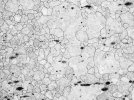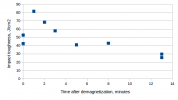- Joined
- Mar 27, 2013
- Messages
- 209
Effect of grain size on impact toughness of carbon steel
I have tested the effect of grain size on impact toughness of carbon steels. The impact toughness was measured by Charpy impact pendulum. The amount of energy absorbed by a specimen during fracture was measured and the result was divided by the cross sectional area of the specimen. Specimens were 3-5 mm thick steel slabs (un-notched). The grain size was determined with microscope. In Figure 1 is shown my test results for carbon steel at 60 HRC.
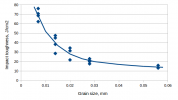
Fig. 1. The effect of grain size on impact toughness of carbon steel at 60 HRC.
Grain size of 0.02 mm is normal situation. When a smith overheats a blade, he will get grain size around 0.05 mm. Grain size smaller than 0.01 mm can be attained when steel has carbides or other grain refining agents which prevent grain growth. Modern carbon steels usually have small (0.015-0.03%) addition of aluminium, which prevent grain growth. Al is not mandatory in steel standards, but it is common practice of steel factories to add Al. Figure 2 demonstrates the effect of Al addition on impact toughness. The steel with Al have smaller grain size and for that reason higher impact toughness. However, the difference diminishes when high tempering temperatures are used.

Fig 2. The effect of Al addition on impact toughness of carbon steel after different tempering temperatures. Steel with 0.025% aluminium (blue diamonds) is compare to a steel which does not have added aluminium (red squares)
Also addition of about 0.15% vanadium prevents grain growth. Vanadium is easier to use and it have more reliable effect than aluminium, but it is more expensive. My blades are made of vanadinium containing 80CrV2 steel. They surely have small grain size, and for that reason, they have sufficient toughness at hardness level of 63 HRC.
Why grain size affects on toughness ?
The toughness decreases with increasing grain size, because coarse grain size promotes brittle grain boundary fracture. In the Figure 3 is shown the fracture surface of very fine grained and extremely coarse grained steels. The fracture surface of coarse grained steel reveals individuals grains.
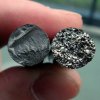
Fig. 3. fracture surface of fine (left) and extremely coarse (right) grained steels
It is difficult to study fracture surface with light microscope, because its shallow depth of field. For that reason, I used electron microscope. I hardened three carbon steel specimens from different temperatures and got three different grain sizes. In Figure 4 is shown an elecron microscope image of fine grained fracture surface. The fracture is trans-granular; it propagates through the grains. Figure 5 shows fracture surface of semi-fine grained steel. In this case the fracture has mixed mode. Fracture goes along grain boundaries revealing some crystals, but it also goes through the grains. In Figure 6 is shown brittle grain boundary fracture of steel with large grain size.
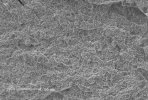
Fig 4. Trans-granular fracture of fine grained steel. Fracture propagates through grains.

Fig 5. Mixed fracture mode of semi-fine grained steel. Fracture propagates along grain boundaries and through grains.
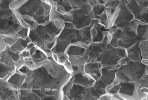
Fig 6. Grain boundary fracture of corse grained steel.
It is well known fact that fracture mode gradually changes from trans- to inter-granular with increasing grain size. But it is not fully understood why it happens. Anyway, grain boundary fracture is very brittle; therefore, coarse grained steel is brittle.
Good tempering temperature for fine grained carbon steel is 180 C
Tempering increases toughness in two different ways. It decreases hardness by making metal crystals more deformable, and it increases strength of grain boundaries. Thus, with increasing tempering temperature coarse grained steel can attain toughness of fine grained steel, as shown in Figure 2. But if you want high hardness you should use low tempering temperatures. Then make sure that you have fine grain size. According to my tests, blades with fine grained carbon steel have sufficient toughness after tempering at 180 C (350 F), which produces about 62 HRC hardness. But in many situations, even lower tempering temperatures can be used.
http://www.juhaperttula.com/
I have tested the effect of grain size on impact toughness of carbon steels. The impact toughness was measured by Charpy impact pendulum. The amount of energy absorbed by a specimen during fracture was measured and the result was divided by the cross sectional area of the specimen. Specimens were 3-5 mm thick steel slabs (un-notched). The grain size was determined with microscope. In Figure 1 is shown my test results for carbon steel at 60 HRC.

Fig. 1. The effect of grain size on impact toughness of carbon steel at 60 HRC.
Grain size of 0.02 mm is normal situation. When a smith overheats a blade, he will get grain size around 0.05 mm. Grain size smaller than 0.01 mm can be attained when steel has carbides or other grain refining agents which prevent grain growth. Modern carbon steels usually have small (0.015-0.03%) addition of aluminium, which prevent grain growth. Al is not mandatory in steel standards, but it is common practice of steel factories to add Al. Figure 2 demonstrates the effect of Al addition on impact toughness. The steel with Al have smaller grain size and for that reason higher impact toughness. However, the difference diminishes when high tempering temperatures are used.

Fig 2. The effect of Al addition on impact toughness of carbon steel after different tempering temperatures. Steel with 0.025% aluminium (blue diamonds) is compare to a steel which does not have added aluminium (red squares)
Also addition of about 0.15% vanadium prevents grain growth. Vanadium is easier to use and it have more reliable effect than aluminium, but it is more expensive. My blades are made of vanadinium containing 80CrV2 steel. They surely have small grain size, and for that reason, they have sufficient toughness at hardness level of 63 HRC.
Why grain size affects on toughness ?
The toughness decreases with increasing grain size, because coarse grain size promotes brittle grain boundary fracture. In the Figure 3 is shown the fracture surface of very fine grained and extremely coarse grained steels. The fracture surface of coarse grained steel reveals individuals grains.

Fig. 3. fracture surface of fine (left) and extremely coarse (right) grained steels
It is difficult to study fracture surface with light microscope, because its shallow depth of field. For that reason, I used electron microscope. I hardened three carbon steel specimens from different temperatures and got three different grain sizes. In Figure 4 is shown an elecron microscope image of fine grained fracture surface. The fracture is trans-granular; it propagates through the grains. Figure 5 shows fracture surface of semi-fine grained steel. In this case the fracture has mixed mode. Fracture goes along grain boundaries revealing some crystals, but it also goes through the grains. In Figure 6 is shown brittle grain boundary fracture of steel with large grain size.

Fig 4. Trans-granular fracture of fine grained steel. Fracture propagates through grains.

Fig 5. Mixed fracture mode of semi-fine grained steel. Fracture propagates along grain boundaries and through grains.

Fig 6. Grain boundary fracture of corse grained steel.
It is well known fact that fracture mode gradually changes from trans- to inter-granular with increasing grain size. But it is not fully understood why it happens. Anyway, grain boundary fracture is very brittle; therefore, coarse grained steel is brittle.
Good tempering temperature for fine grained carbon steel is 180 C
Tempering increases toughness in two different ways. It decreases hardness by making metal crystals more deformable, and it increases strength of grain boundaries. Thus, with increasing tempering temperature coarse grained steel can attain toughness of fine grained steel, as shown in Figure 2. But if you want high hardness you should use low tempering temperatures. Then make sure that you have fine grain size. According to my tests, blades with fine grained carbon steel have sufficient toughness after tempering at 180 C (350 F), which produces about 62 HRC hardness. But in many situations, even lower tempering temperatures can be used.
http://www.juhaperttula.com/


